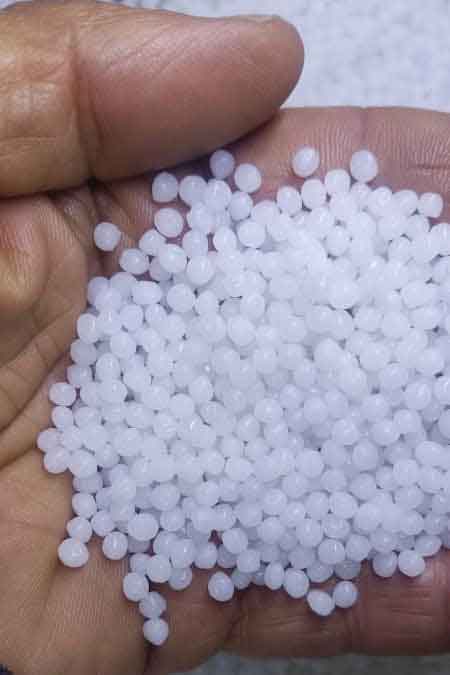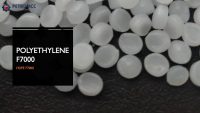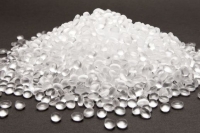Project Description
Polyethylene (PE) is a thermoplastic polymer composed of ethylene monomers. It is one of the most commonly used plastics due to its versatility, low cost, and wide range of applications. PE is produced through the polymerization of ethylene gas, resulting in a material with excellent strength, durability, and resistance to chemicals and moisture. It is used in various industries, including packaging, agriculture, construction, automotive, and healthcare. Polyethylene comes in different forms, such as high-density polyethylene (HDPE) and low-density polyethylene (LDPE), each with its own set of properties and applications.
| Name | Polyethylene |
| Manufacturer | ARAS PETROCHEMICAL |
| Made By | PETRO-ACC |
| Product Code | PE |
POLYETHYLENE FEATURES
Polyethylene is a versatile synthetic polymer that has numerous features and applications. Here are some key features of polyethylene:
- Lightweight: PE is a lightweight material, making it easy to handle and transport.
- Chemical resistance: It has excellent resistance to many chemicals, including acids, alkalis, and solvents, which makes it suitable for various industrial applications.
- Water resistance: PE is highly resistant to water, making it useful for products that need to be water-resistant or waterproof.
- Electrical insulation: It has good electrical insulation properties, making it suitable for applications in the electrical and electronics industries.
- Flexibility: PE is a flexible material, allowing it to be easily molded into different shapes and sizes. It can also withstand repeated bending and flexing without breaking.
- Low friction: It has a low coefficient of friction, which means that objects can slide easily over its surface. This property makes it suitable for applications where reduced friction is desired, such as in packaging and conveyor systems.
- Thermal insulation: PE has low thermal conductivity, providing insulation against heat transfer. It is commonly used in insulation materials for pipes, cables, and construction applications.
- Impact resistance: It exhibits high impact strength, making it resistant to breaking or shattering under impact loads. This property is particularly useful in applications where durability is required, such as in packaging, automotive parts, and toys.
- Food-safe: PE is non-toxic and approved for use in food packaging and containers, as it does not leach harmful substances into food.
- UV resistance: Some forms of polyethylene are resistant to ultraviolet (UV) radiation, making them suitable for outdoor applications where prolonged exposure to sunlight is expected, such as in agricultural films and outdoor furniture.
These features contribute to the widespread use of polyethylene in various industries, including packaging, construction, automotive, electrical, agriculture, and healthcare.
Polyethylene Applications
Polyethylene has numerous applications across various industries due to its desirable properties. Here are some common applications of polyethylene:
- Packaging: PE is extensively used in packaging materials such as plastic bags, films, and containers due to its excellent moisture barrier properties and flexibility.
- Construction: It is widely used in the construction industry for pipes, fittings, geomembranes, and insulation materials. Polyethylene pipes are durable, lightweight, and resistant to corrosion, making them ideal for water and gas distribution systems.
- Automotive: PE is used in automotive applications for manufacturing fuel tanks, bumpers, cable insulation, and interior components. Its impact resistance, low weight, and chemical resistance make it suitable for these applications.
- Agriculture: Polyethylene is used in agricultural applications such as greenhouse films, mulching films, and irrigation systems. These films provide protection against pests, control moisture levels, and enhance crop growth.
- Electrical insulation: PE is used as an insulating material in electrical wires and cables. Its excellent electrical properties, including high dielectric strength and low dielectric loss, make it an ideal choice for insulation.
- Consumer goods: PE is found in a wide range of consumer products, including toys, household containers, bottles, and packaging for food and beverages. Its safety, durability, and ease of molding make it popular in these applications.
- Medical: In the medical field, polyethylene is used for manufacturing medical devices and packaging materials. It is commonly used for items such as syringes, catheters, surgical implants, and flexible packaging for pharmaceuticals.
- Sports and recreation: Polyethylene is used in the production of sports equipment, such as kayaks, canoes, playground equipment, and artificial turf. Its lightweight nature, durability, and impact resistance contribute to its suitability for these applications.
- Industrial applications: Polyethylene is employed in various industrial applications, including chemical storage tanks, liners for ponds and reservoirs, conveyor belts, and industrial coatings. Its chemical resistance and low friction properties make it useful in these environments.
- Recycling: Polyethylene can be recycled into new products, including plastic lumber, plastic bags, and composite materials. Recycling helps reduce waste and conserves resources.
These are just a few examples of the many applications of polyethylene, highlighting its versatility and widespread use across different industries.
Polyethylene Formulation
There are different types of polyethylene formulations available, each with specific characteristics suited for particular uses. Here are a few commonly used polyethylene formulations:
- Low-density polyethylene (LDPE): LDPE has a high degree of branching in its molecular structure, resulting in a low-density and flexible material. It is used in packaging films, plastic bags, and squeeze bottles.
- High-density polyethylene (HDPE): HDPE has a more linear molecular structure, leading to higher density and greater strength. It is used in applications requiring rigidity, such as pipes, containers, and geomembranes.
- Linear low-density polyethylene (LLDPE): LLDPE is a blend of LDPE and linear polyethylene. It combines the flexibility of LDPE with the strength of HDPE. LLDPE is commonly used in film applications, such as stretch wrap, agricultural films, and liners.
- Medium-density polyethylene (MDPE): MDPE is a material with properties falling between LDPE and HDPE. It is used in applications that require a balance of strength and flexibility, such as gas pipes and cable insulation.
- Ultra-high-molecular-weight polyethylene (UHMWPE): UHMWPE has an extremely high molecular weight, resulting in exceptional wear resistance and impact strength. It is used in applications like bearings, gears, and medical implants.
These are just a few examples of PE formulations, and there are many other variations and blends available to cater to specific requirements in industries such as packaging, construction, automotive, and more.
Polyethylene Packing
Polyethylene packing refers to the use of PE, a versatile and commonly used plastic, for packaging purposes. PE is a durable and flexible material that can be molded into various forms, such as bags, films, and foam, making it suitable for protecting and securing goods during storage and transportation. Polyethylene packing is widely used in industries such as food and beverage, pharmaceuticals, electronics, and e-commerce for its protective properties, resistance to moisture and chemicals, and cost-effectiveness.
Polyethylene packing would be in different types:
25 kg polypropylene bags with pallet and shrink.
PE capacities for a different way of shipments would be as below:
20ft & 40ft containers for sea shipment:
20ft FCL: 13 MT/25 kg bags with pallets
40ft FCL: 25 MT/25 kg bags with pallets
The capacity of a Full truck: 25 MT
POLYETHYLENE STORAGE
Polyethylene storage refers to the use of containers or tanks made from PE, a durable and versatile plastic, for storing various substances. PE storage solutions are widely used in industries such as chemicals, pharmaceuticals, food processing, agriculture, and water treatment, among others. PE is chosen for storage purposes due to its excellent chemical resistance, low cost, and ease of fabrication.
Polyethylene storage tanks are available in different sizes and configurations to accommodate varying storage needs. These tanks can be used to store liquids, such as water, chemicals, fuels, and food products, as well as granular or powdered materials. They are designed to withstand a wide range of temperatures and can be made to meet specific requirements for pressure, temperature, and compatibility with stored substances.
Polyethylene storage containers are known for their corrosion resistance, lightweight, and UV stability, making them suitable for both indoor and outdoor applications. These containers are typically seamless, which reduces the risk of leaks and contamination. They are also easy to clean and maintain.
When using PE storage for hazardous substances, it is essential to ensure compliance with applicable safety regulations and guidelines. Proper ventilation, handling procedures, and secondary containment measures should be implemented to minimize risks and ensure the safe storage of materials.
In summary, PE storage provides a cost-effective and reliable solution for storing a wide range of substances. Its chemical resistance, durability, and flexibility make it a popular choice for various industries requiring efficient and safe storage options.
POLYETHYLENE SPECIFICATION
The specifications of polyethylene can vary depending on the specific grade and intended application. However, some general specifications for polyethylene include:
- Density: Polyethylene typically has a density ranging from 0.91 g/cm³ to 0.96 g/cm³. The density affects the material’s strength, stiffness, and impact resistance.
- Melt Flow Index (MFI): MFI is a measure of the melt viscosity of polyethylene and indicates the ease of processing. It is typically specified as a range or a specific value in g/10 min.
- Tensile Strength: The tensile strength of polyethylene can range from 10 MPa to 40 MPa, depending on the grade. It represents the material’s ability to withstand pulling forces without breaking.
- Flexural Modulus: The flexural modulus, measured in MPa, indicates the stiffness or rigidity of polyethylene. It can vary from 100 MPa to 1500 MPa.
- Melting Point: The melting point of polyethylene is typically in the range of 120°C to 135°C. It is the temperature at which the material transitions from a solid to a liquid state.
- Chemical Resistance: Polyethylene is generally resistant to a wide range of chemicals, including acids, bases, and solvents. However, the resistance may vary depending on the specific grade and chemical exposure conditions.
- Environmental Stress Cracking Resistance (ESCR): ESCR is a measure of the resistance of polyethylene to cracking when exposed to stress in the presence of chemicals or environmental factors. It is typically specified as a number of hours.
These specifications can be further refined based on the specific requirements of the application, such as desired flexibility, impact resistance, UV resistance, and others.





